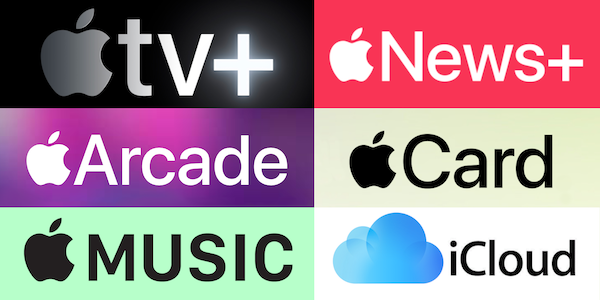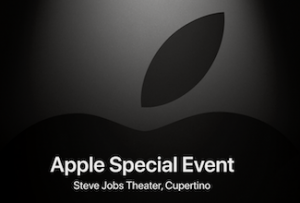Apple solidifies its transition to a services company
Posted on
by
Kirk McElhearn
 It’s no surprise that Apple is changing. As we’ve seen in the past couple of years, smartphone sales are flat, and the company’s other hardware doesn’t make the splash in the market that it used to. Sure, the Apple Watch is selling well, with Apple taking more than half of the global smartwatch market, and the company’s wearables—the Apple Watch and AirPods—are “approaching the size of a Fortune 200 company,” according to Tim Cook.
It’s no surprise that Apple is changing. As we’ve seen in the past couple of years, smartphone sales are flat, and the company’s other hardware doesn’t make the splash in the market that it used to. Sure, the Apple Watch is selling well, with Apple taking more than half of the global smartwatch market, and the company’s wearables—the Apple Watch and AirPods—are “approaching the size of a Fortune 200 company,” according to Tim Cook.
Apple knows that the hardware market is getting tougher, as smartphones become commodified and price pressure will make it difficult for the company to maintain the current prices and margins of their flagship devices. In early 2017, Apple said that they would double their services revenue by the end of 2020, and the company is on target to do so, even if the growth in services income is slowing.
 Apple’s March 25 event was interesting in that the company did not present any new hardware (but had updated a number of products the previous week, without any fanfare). It opened with an explanation of what “services” are. This was a curious choice, as though the presentation was more for shareholders than consumers or the press.
Apple’s March 25 event was interesting in that the company did not present any new hardware (but had updated a number of products the previous week, without any fanfare). It opened with an explanation of what “services” are. This was a curious choice, as though the presentation was more for shareholders than consumers or the press.
Apple introduced several new services on March 25: news, TV, games, and a credit card. (Read our overview of the March 25 event.) These services are going to help Apple solidify its non-hardware income, but also start pointing toward a potential bundle of services from the company.
Apple is transforming
In November of last year, I wrote about how Apple is changing from a hardware company to a services or media company, and the March 25 event showed that this is the case. Apple’s services catalog is expanding quickly, even though most of the new services won’t be available until the summer or fall. And the idea of an “Apple Prime” subscription, which I discussed in my November article, has become even more compelling. (Given the company’s new nomenclature for all of its recent services, I would think they might call it Apple+.)
Think of the many services you can subscribe to from Apple:
- iCloud storage: for most people, this is $1 or $3 a month, but can reach $10 a month for 1 TB of storage.
- Apple Music: $10 a month, though it’s only $100 if you re-up for a full year. Students pay $5 a month. A family plan is $15 a month.
- Apple News+: $10 a month; no annual subscription rate yet.
- Apple Arcade: no pricing was announced, but it’s conceivable that this, too, would sell for the easily digestible round number of $10 a month.
- Apple TV+: this is a tough one to call. Apple may give this programming away as a loss leader, since they’ll get people to buy other channels from Apple through its TV app, or they may charge for it. If there is only Apple’s original content, it’s hard to see the company charging $10 a month, and, as yet, Apple has not suggested that they would bundle other streaming content with this service.
- AppleCare+: if you have an iPhone or other Apple device, this is optional; however, if you buy an iPhone using the Apple Upgrade Program, this is required. Apple used to sell this at a fixed price for two years, but now offers it at $10 a month for the iPhone XS or XS Max.
Add those services up, and you get potentially around $40 a month, or $30 for people who don’t buy AppleCare. Or potentially more; the iCloud storage could be up to $10 a month for 1 TB (although most people don’t buy that much storage), and we don’t know yet whether, or how much, Apple might charge for Apple TV+.
What Apple might do next
If Apple were to add the cost of an iPhone into a subscription bundle—on the upgrade program, so users would get a new phone each year—they could sell a single subscription to hardware and services.
This is a powerful idea; individual subscriptions add up and seem like they cost more than one monthly payment for a bundle, and Apple could lock in consumers with this sort of plan. (And even potentially provide cellular service, as an MVNO: a mobile virtual network operator.)
Once people take out subscriptions, they often don’t change them. It’s not that they’re hard to change or cancel, but people get used to them. (To learn how to edit or cancel Apple subscriptions, see this article.) Getting a few tens of millions of users to pony up, say, $100 a month for an iPhone, AppleCare+, and other services, would provide a potent revenue stream. (For each million users, that would come to $1.2 billion.) You can’t deny that this is a very enticing idea, and it’s easy to imagine that Apple will head down this route in the future.
 But consider one other element of the March 25 presentation. The service that may net Apple the most revenue over time is the one whose cost you don’t see: the Apple Card. Just as with Apple Pay, where the company gets a fraction of what you spend on each purchase using this service, the Apple Card could potentially provide Apple with more revenue over time, and change the company even more than these content services.
But consider one other element of the March 25 presentation. The service that may net Apple the most revenue over time is the one whose cost you don’t see: the Apple Card. Just as with Apple Pay, where the company gets a fraction of what you spend on each purchase using this service, the Apple Card could potentially provide Apple with more revenue over time, and change the company even more than these content services.
Given the company’s presence around the world, and excellent reputation, an Apple Bank may be in the cards some time in the future.
Related articles:
How Apple is changing from a hardware company to a services and media company
At your service: The full lowdown on Apple TV+, Apple News+, Apple Card, and Apple Arcade
How can I learn more?
 We’ll have an in-depth discussion of Apple’s transition to a services company on this week’s episode of the Intego Mac Podcast, so be sure to subscribe to make sure you don’t miss the latest episode. You’ll also want to subscribe to our e-mail newsletter and keep an eye here on The Mac Security Blog for updates.
We’ll have an in-depth discussion of Apple’s transition to a services company on this week’s episode of the Intego Mac Podcast, so be sure to subscribe to make sure you don’t miss the latest episode. You’ll also want to subscribe to our e-mail newsletter and keep an eye here on The Mac Security Blog for updates.
You can also follow Intego on your favorite social and media channels: Facebook, Instagram, Twitter, and YouTube (click the ? to get notified about new videos).
What do you think, readers? Will Apple offer a bundle of services, and it so, what might it look like? And how will Apple continue to change as a company? Share your ideas in the comments below!